Advanced Logistic Systems Vol. 6. No. 1. (2012) pp. 89-94.
E-TRAVEL LOGBOOK IN OFFICIAL PROCEDURE
ZSOLT CZÉKMANN1
Abstract: In the time of the Infocommunication society it is obvious we use the new generation
technologies in our every day actions. The man of the digital age was made for to use these
appliances to surmount his environment. But was the „legal environment” ready for the
infocommunication technologies? A simple GPS based e-log book - which can be used as simple as
an ordinary log book – distressed the offices. For the solution we had to wait till the hole official
procedures processed and reached the 21. century. Their trust in the infocommunication's
technologies depends on their acceptance by the society, and the legislator's activity contributes to it
(or interferes it) vigorously. In our case we examine that a simple document with an elaborated
technological foreground how it goes through the mill, thanks to the legal changes.
Keywords: e-travel, Infocommunication society, law of the transportation
1. New technologies and law
By the second decade of the XXI. century the tools of infocommunication became the
part of our days uneventfully, infiltrating in our in our life in such a way that their
attendance is next to unperceivable, but their absence is a serious challenge for us in short
run too. The post-industrial societies, in which the digital tolls and applications are working
as society-shaping force, called infocommunication society. 2
These societal transformations' obligate attendants are the transformations of the
societal connections and the maturation of new systems of rules and relations. The law – as
one of the most dominant societal systems of rules – will be forced to take up the question
according the new occurrent phenomena sooner or later, even if the legislator does even
later, then sooner. The legislator has a specially delicate situation, if the environment to be
regulated is changing so dynamically, outranking the considered juridical mechanisms
successively. So it happens if the object of the regulation connects with the use of all-time
state-of-the-art technology, then the legislator(and the law enforcer) implements the new
technology, creates the regulation, by the time the enforcement could gain currency and the
practice of courts could evolve, then the regulated solution is already transcended, and in
this way the regulation too.3 This phenomenal generates problems on the site, on which the
1MSc., assistant lecturer, University of Miskolc
jogczzs@uni-miskolc.hu
H-3515 Miskolc-Egyetemváros, Hungary
2About the information and infocommunication society: Daniel Bell: The Coming of Post-Industrial Society. New
York, Basic Books, 1976; Frank Webster (2002) Theories of the Information Society. London: Routledge; Balogh
Zsolt György: Az infokommunikációs jogról, Infokommunikáció és Jog, 02. szám 2004., Dialog Campus Könyvek
Budapes-Pécs, Torma András: Az információ jelentősége a (köz)igazgatásban. Budapest: Virtuóz, 2002.
3 The situation is similar – for example – by the defence of intellectual property. By the time the legislator had
created the opportunity of the effective counter-movee against the multitudinous duplication on the physical
carrier, there were the new technologies (for example: the FTP or the torrent-file sharing method) and virtually
�
90 E-travel logbook in official procedure
binding regulation draws the line at the use of analogy, respectively from the status of the
parties follows the pretence of a strict regulation (when the state, as the wielder of the
executive power, is the subjective of the legal relations). On the basis of this all and in the
interest of that the electronic document becomes utilizable in the magisterial procedure, the
legislator is in a fix, specially if we take account of that the number of the type of cases is
more than ten thousands and that's why the mulding is not simple. The problem is given
and now the solution(or the attempt of this) though the example of the electronic travelling
warrant.
2. E-administration
To find the correspondences between the difficulties of the electronic documents' use,
we need to scrutinize how the current Hungarian rules of procedure evolved.
2.1. From the electronic administration to the e-public administration, there and back.
In Hungary the rules of magisterial procedure was re-regulated in 2004, it materialized in
the Act CXL of 2004 on the general rules of administrative proceeding and services (called
Ket.) It is relevant to place emphasis on that the Ket. came into effect after joining the
European Union, reflecting the specialties of the EU's harmonization of law. One of the
most expressive instances is the Chapter X about the Electronic Administration, which
appraised the opportunity of the electronic way of the administrative proceeding foremost.
The electronic procedural regulation was unknown in the inland legislation till this
the electronic
event(however
administration 5 and the electronic way 6, with which it opened the door to use of the
electronic documents7 in magisterial proceeding. But the door was opened just on the face
of it, namely because the self governments and governments got the authority to foreclose
certain cases from the electronic way(and it eventued by the great majority of cases8), so
there was only a narrow breach, across which the e-documents and electronic proceeding
could begin their career. The digital travelling warrant was not found between the
receivable documents.
it had antecendents) 4 . The Act defined as first:
The breakthrough came with the 2007-2013 budget of the EU, together with the
transformation of the regulating environment. The eEuropa 2002 Strategy9 had already set
an aim to work up the information society, and it had determined the group of basic
they squeezed out the former rules too, because the law (and extremly the criminal law) obviates the use of
analogy.
4 The Act XXXV of 2001 about the electronic signatures, Directive 1999/93/EC of the European Parliament and of
the Council of 13 December 1999 on a Community framework for electronic signatures., The Act CVIII of 2001
about electronic commercial services, about some questions according the services of information society.
5 Electronic administration: the administrative magisterial cases equipment in electronic way, and the totality of
the needful contentional and formal technical circumstances of work.
6 Electronic way: the completion of actions of procedure through electronic data processing, data holding and
forwarding, line-, raditechnical optical or electro-magnetical tools
7 Electronic document: joint of data which can be defined through electronic tools
8 The reason is usually the absence of infrastructure, respectively the absence of the needful liquid assets
9 ttp://europa.eu/legislation_summaries/information_society/strategies/l24226a_en.htm (21. april 2012)
�
Zsolt Czékmann 91
services 10 , which must be accomplished for the private and economic sphere by the
government. It ensured the sources of the new budget for it and the working out of the
electronic services became an emphasised field.11
Falling into step with the new aims of the budget the eEuropa 2002 Strategy improved
in eEuropa 2005 (keeping the original aims till the last), then the new budget set the source
with expanded content for the information society in the i2010 Strategy.12
The stronger and stronger countenance of the European Union according working out
the information society meant commitment too for the member states next to the
opportunity. This resulted in the Directive 2006/123/EC of the European Parliament and of
the Council of 12 December 2006 on services in internal market.
3. E-logbook as documentation
The Ket. (§52.) laid the opportunity for using of the documents in the administrative
proceeding. The utilizable documents (and peculiarly the group of the legal documents) can
be narrowed onwards in certain proceedings by the type specific rules.13
Let's examine the general requirements for the documents, and then compare them with
specific requirements of travelling warrant.
In the interest of proving the contest which it incorporates, the documents must to
measure up to the requirement of the identification, thruthfulness, integrity, undeniability.
The former four requirements' fruition must be ensured without reference to the technology
of preparation unconventionally, it refers to the original paper documents equally in this
way, together with the electronic documents. This points to the fact the distinction can be
based only on law, wit the rule decided which document can be accepted out of the
documents (found in the part 2.)
If we examine the two cycles, when the electronic travelling warrant could be used
(2009-2011)14, respectively the following cycle when the same technology did not suit the
legal requirements, we can see that the requirements didn't change, all in all the rules to
make the opportunity of the electronic way emerged.
So between 2009-2011 the travelling warrant's terms within named:
a) The designation of the Upkeeper, the name of the Driver
b) Registration number and premise of the vehicle
c) Data of carriage, number of persons, departure, stops, location and date of arrival,
status of Km-Clock, the charged Km-yield,
with this end in view it must be proved with a strict major blank, or with an electronic
document accordingly.
10 Common List of Basic Public Services contains 12 services, which the private sphere has resort to and the8
services, which must be ensured for the economic sphere.
http://ec.europa.eu/information_society/eeurope/2002/action_plan/pdf/basicpublicservices.pdf (01-05-2012)
11
Keringer Zsolt: Elektronikus közigazgatás
I. part http://terinformatika-online.hu/index.php?option=
com_content&task=view&id=103&Itemid=1 (2007. szeptember 08)
12 Europen Digital Agenda
http://europa.eu/legislation_summaries/information_society/strategies/si0016_hu.htm (21.april 2012)
13 § 190-199 in the Act III of 1952, Judicial Procedure Code
14 http://www.nkh.hu/Gepjarmu/tevekenysegek/jarmuvekhaszn/egyebokmanyok/menetfuvarok/Lapok/default.aspx
(21. april 2012)
�
92 E-travel logbook in official procedure
From 2012 these rules for the same travelling warrant are the following:
The designation of the Upkeeper, the name of the driver
Registration number and premise of the vehicle
In case of transit: Data of carriage (number of travelling warrants made by Ware-
Owner, the designation, amount and origin of carriage, wise of package; In case
of dangerous ware, the ADR data)
departures', stops' and arrivals' (and stowages') location and date, status of Km-
Clock, together with the charged Km-yield.
On the merits there is no difference, the Electronic GPS Documentation is competent to
provide the required information, but the accepted technology lost its availability without
authorization in the magisterial proceeding as it reads well through the orientation on the
website of National Transport Authority.15
This actuality procedures an awkward situation in the progress of relations' system of
the legislation-technology (detailed in the Point 1.), on the basis of that the regulation isn't
statute-barred on the grounds of technology's development, on the contrary we can take
cognizance of that the technology became to be “exceeded”, because of the legal
environment's transformation. It's true, that the regulation chooses the not-forward solution,
but it means withdrawal compared to the former legal regulation. Inasmuch as there is no
statement, which reflects on the question if the inducted e-documentation came up to the
expectations, and such a technological change didn't eventuate, which made the elaboration
of new regulation's system justified, hence the law enforcer remained without soothing
answer, in respect to the changes which existed behind.
Both the European Union's legal trends and the Hungarian legal way proceeds
consistently to the mutual acceptability of the paper-based documents and the electronic
documents. With this end in view of the principles of the technology's neutrality and the
interoperability it is expectable from the legislator of any states which called itself an
Infocommunication society to make this minimal expected step, namely to aim to create the
equivalence between the documents. In every respect for the law enforcer's trust in the e-
documents (which has a special emphasised role in EU 2020 Information society Strategy)
such an inconsistent legislation of the legislator means a serious danger. It's specifically
dangerous in an environment, in which the traditional (paper-based) documents prevail (in
contrast with the vitally digital based societies, for example in Japan)
The dark curtain on the e-travelling warrant seems to lift, namely in August of 2012 the
legislator - perceiving the untenable situation of the regulation – traces the electronic way
back to the channel of legality. The 228/2012 (VIII. 23.) Government Decree § 6 (10)
(operative from 22. October 2012) makes possible the use of the electronic travelling
warrant. It won't be restored to the former liberal legislation, just in narrow circle, in case of
15 „Electronic letter of carriage or travelling warrant 261/ 2011 (XII. 7.) Government Decree and other regulation
don't contain the definition, the terms, the approval, the quality, the usage, the control and the use's opportunity of
electronic letter of carriage or travelling warrent. In stead of no other specifically strict major blank can be used
electronic version of it automatically, regulation must permit it. On the basis of this all the driver must keep a
record on the paper based letter of the carriage and must show it in case of control. The document must be retained
accordance with serial number for 8 years. Any electronic letter of carriage can be a statement to help the internal
function of the enterprise, but it is not eligible for magisterial aims!” (21.april 2012)
�
Zsolt Czékmann 93
the several accounted vehicular ware-transportation16 it is possible to use the electronic
documentation.
In regard to that the travelling warrant is a strict major blank, so (rightly) the rule seized
the condition of the use of e-documents. In case of electronic travelling warrant the defined
data17 must be seized in a closed system automatically or in the time of their availability.
The record equipment of the electronic document must be able to
a. visualize the actual content of the stored data holisticly,
b. make an attested printing or to ensure the direct actual download of the stored data
– in the way of the closed informatic system operated by the operator of the vehicle
– for the controlling authority.
That is to say the new legislation returns to the former model, to one technology-neutral
solution. So it means that the former elaborated and operable GPS based systems become to
suited again, even if just in narrower circle, for the involvement of magisterial procedure,
raising hope for the return of the highlight in 2009.
4. Summary
The electronic travelling warrant, as a common recognized proceeding, is an adequate
technically subsidised electronic documenting form's gauntlets
the magisterial
proceeding and it draws perfectly clear picture about the status of the electronic
administration in our country. It's fact, that the documentation in the unchanged form is
unsuitable to use, then it suits to the legal requirements, and nowadays it became „outlaw”
again (but surely not permanently). It represents that the Hungarian electronic public
administration is groping its way yet. The uncertainity of the legislator is recognizable
when the practice tries to shape the elaborated solutions for its own interest in the given
regulating environment, it generates tension between the state's expectations and the
accepted practice.
in
We hope that this process won't make no following sacrifices and we can see the
elaborated well-practiced solutions' resusciation and acceptance.
Acknowledgements
This research was carried out as part of the TAMOP-4.2.1.B-10/2/KONV-2010-0001 project with
support by the European Union, co-financed by the European Social Fund.
16 Several accounted vehicular ware-transportation: is the transportation of the ware or other thing by the economic
entity, if the transported ware or other thing is the property of the transporter or the transporter bought, sold, rented
or created by the transporter, extracted, took over for processing or repairing, processed, repaired thing, and the
aim of the transportation is the carrying of the ware or other thing, or the dispatch from the transportation done by
the operator's or rented vehicle;
17 The designation of the Upkeeper, the name of the driver, registration number and premise of the vehicle.
In case of transit: Data of carriage (number of travelling warrants made by Ware-Owner, the designation, amount
and origin of carriage, wise of package; In case of dangerous ware – with the bias of ministerial decree about the
territorial chemicals and fuels tracked by territorial wrecker or slow vehicle, track trailer - , the ADR data),
departures', stops' and arrivals' (and stowages') location and date, status of Km-Clock, together with the charged
Km-yield.
�
94 E-travel logbook in official procedure
Literature
[1] Bell, D.: The Coming of Post-Industrial Society. New York, Basic Books, 1976;
[2] Webster, F.: Theories of the Information Society. London: Routledge, 2002.
[3] Balogh, Zs. Gy.: Az infokommunikációs jogról, Infokommunikáció és Jog, 02. szám 2004.,
Dialog Campus Könyvek Budapes-Pécs,
[4] Torma, A.: Az információ jelentősége a (köz)igazgatásban. Budapest: Virtuóz, 2002.
[5] Keringer, Zs.: Elektronikus
közigazgatás
http://terinformatika-online.hu/
I.
rész
index.php?option=com_content&task=view&id=103&Itemid=1 (2007. szeptember 08)
[6] Csáki, Gy. B. : Az elektronikus közigazgatás tartalma és egyes gyakorlati kérdései. Budapest,
HVG Orac Kiadó 2010.
�
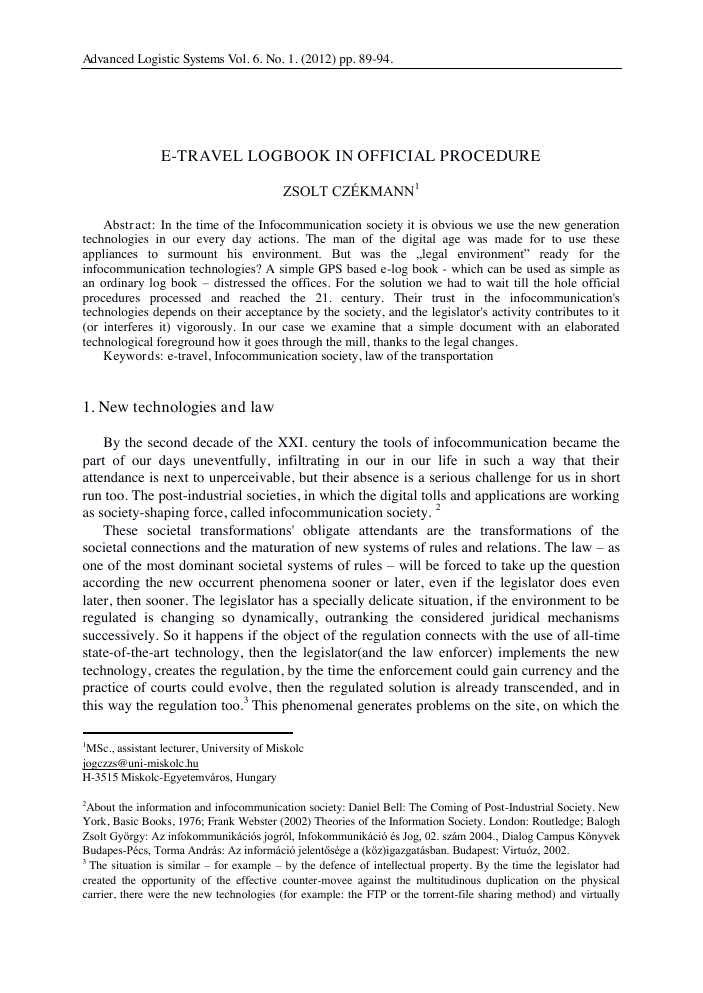
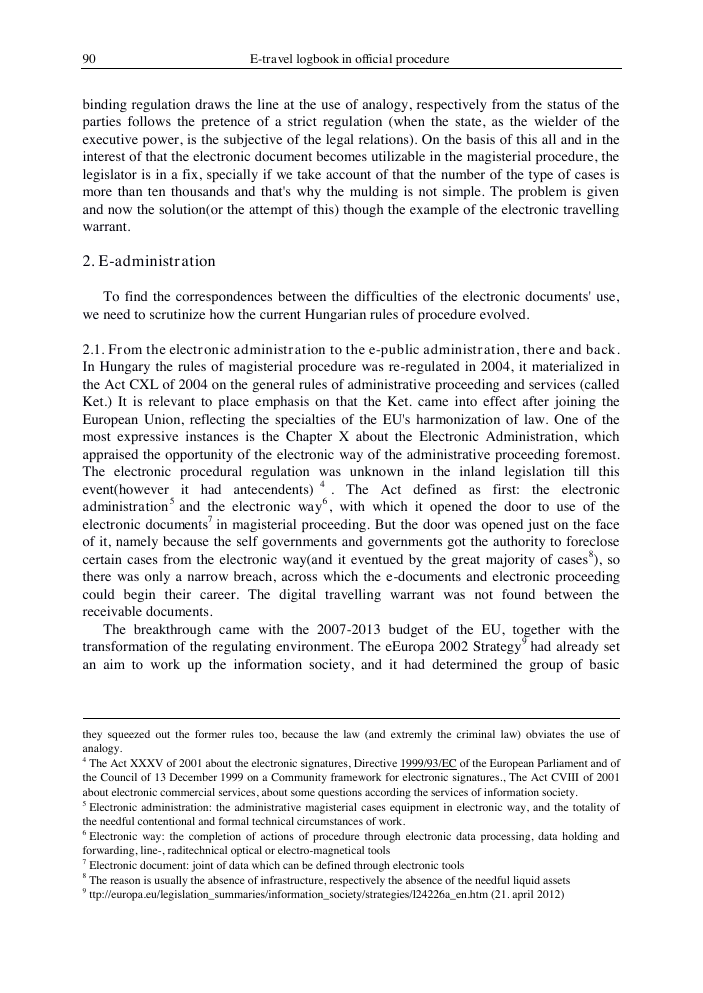

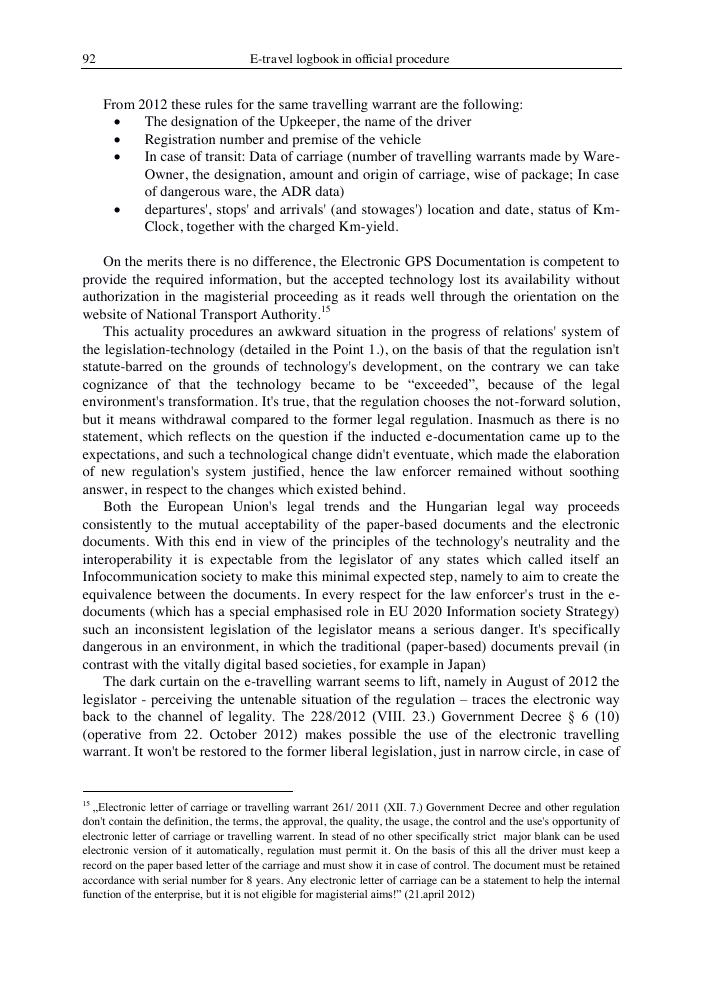
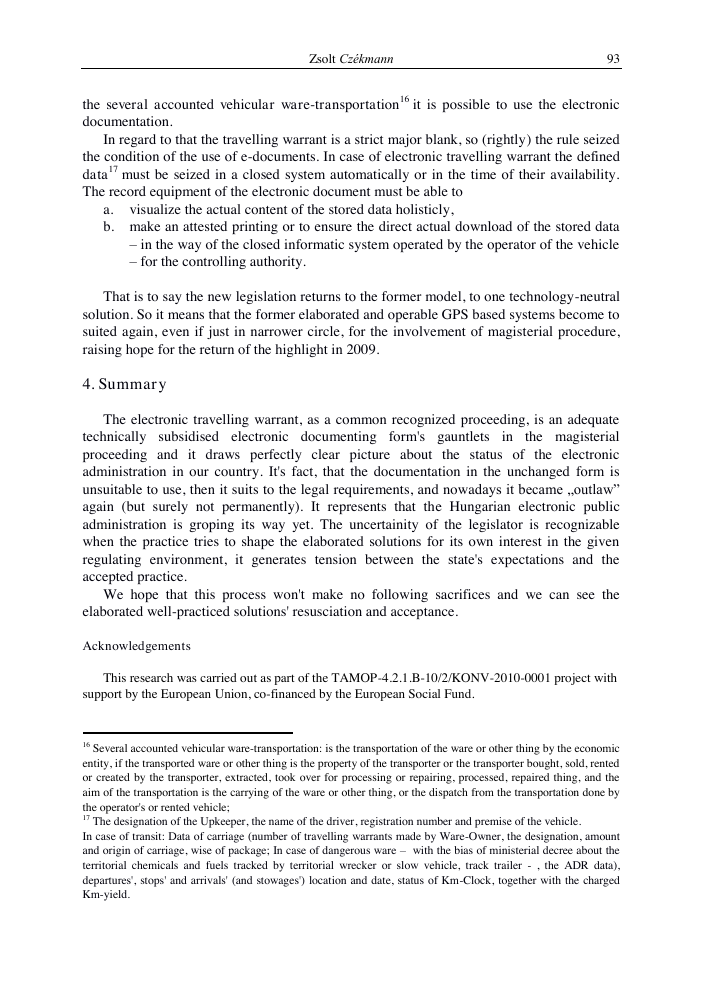
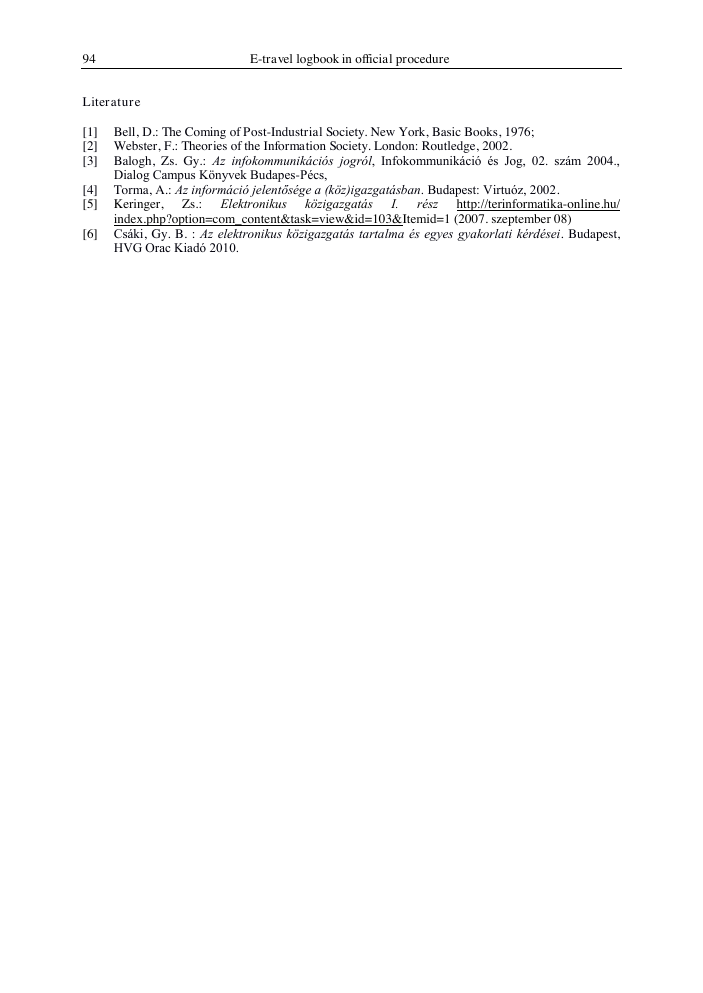






 2023年江西萍乡中考道德与法治真题及答案.doc
2023年江西萍乡中考道德与法治真题及答案.doc 2012年重庆南川中考生物真题及答案.doc
2012年重庆南川中考生物真题及答案.doc 2013年江西师范大学地理学综合及文艺理论基础考研真题.doc
2013年江西师范大学地理学综合及文艺理论基础考研真题.doc 2020年四川甘孜小升初语文真题及答案I卷.doc
2020年四川甘孜小升初语文真题及答案I卷.doc 2020年注册岩土工程师专业基础考试真题及答案.doc
2020年注册岩土工程师专业基础考试真题及答案.doc 2023-2024学年福建省厦门市九年级上学期数学月考试题及答案.doc
2023-2024学年福建省厦门市九年级上学期数学月考试题及答案.doc 2021-2022学年辽宁省沈阳市大东区九年级上学期语文期末试题及答案.doc
2021-2022学年辽宁省沈阳市大东区九年级上学期语文期末试题及答案.doc 2022-2023学年北京东城区初三第一学期物理期末试卷及答案.doc
2022-2023学年北京东城区初三第一学期物理期末试卷及答案.doc 2018上半年江西教师资格初中地理学科知识与教学能力真题及答案.doc
2018上半年江西教师资格初中地理学科知识与教学能力真题及答案.doc 2012年河北国家公务员申论考试真题及答案-省级.doc
2012年河北国家公务员申论考试真题及答案-省级.doc 2020-2021学年江苏省扬州市江都区邵樊片九年级上学期数学第一次质量检测试题及答案.doc
2020-2021学年江苏省扬州市江都区邵樊片九年级上学期数学第一次质量检测试题及答案.doc 2022下半年黑龙江教师资格证中学综合素质真题及答案.doc
2022下半年黑龙江教师资格证中学综合素质真题及答案.doc